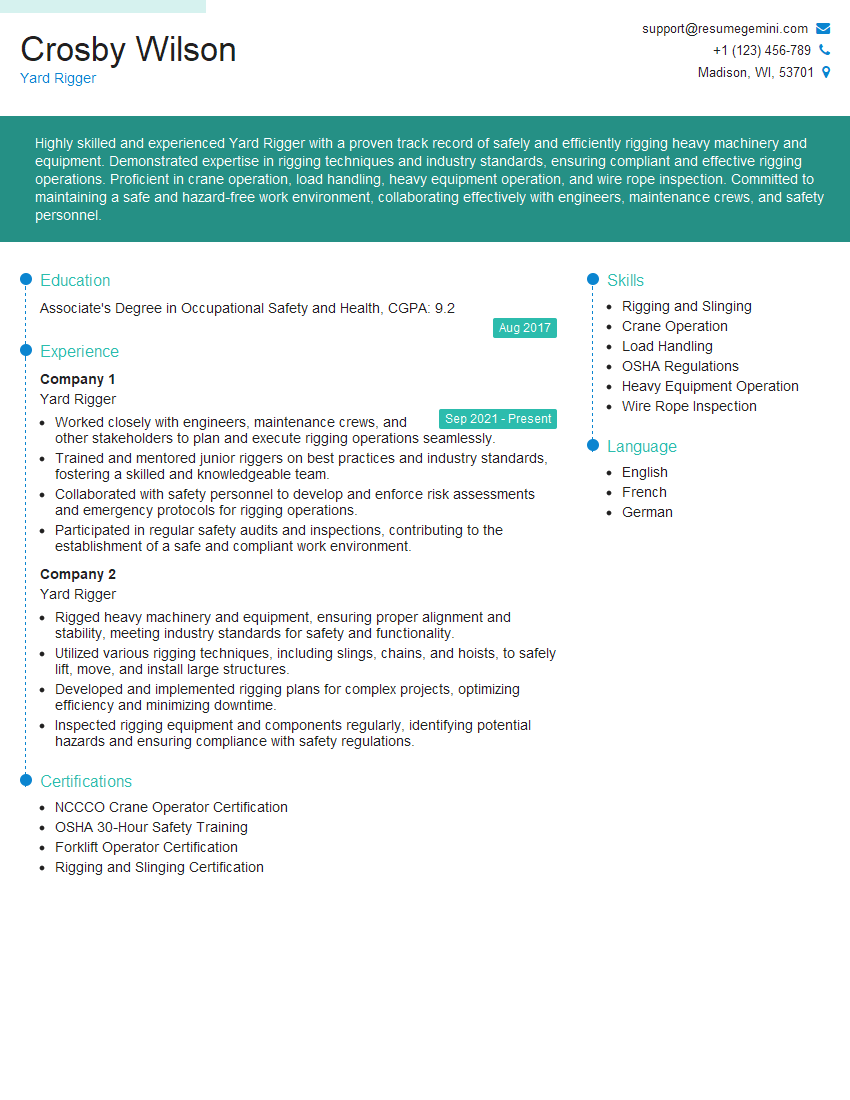Are you a seasoned Yard Rigger seeking a new career path? Discover our professionally built Yard Rigger Resume Template. This time-saving tool provides a solid foundation for your job search. Simply click “Edit Resume” to customize it with your unique experiences and achievements. Customize fonts and colors to match your personal style and increase your chances of landing your dream job. Explore more Resume Templates for additional options.

Crosby Wilson
Yard Rigger
Summary
Highly skilled and experienced Yard Rigger with a proven track record of safely and efficiently rigging heavy machinery and equipment. Demonstrated expertise in rigging techniques and industry standards, ensuring compliant and effective rigging operations. Proficient in crane operation, load handling, heavy equipment operation, and wire rope inspection. Committed to maintaining a safe and hazard-free work environment, collaborating effectively with engineers, maintenance crews, and safety personnel.
Education
Associate’s Degree in Occupational Safety and Health
August 2017
Skills
- Rigging and Slinging
- Crane Operation
- Load Handling
- OSHA Regulations
- Heavy Equipment Operation
- Wire Rope Inspection
Work Experience
Yard Rigger
- Worked closely with engineers, maintenance crews, and other stakeholders to plan and execute rigging operations seamlessly.
- Trained and mentored junior riggers on best practices and industry standards, fostering a skilled and knowledgeable team.
- Collaborated with safety personnel to develop and enforce risk assessments and emergency protocols for rigging operations.
- Participated in regular safety audits and inspections, contributing to the establishment of a safe and compliant work environment.
Yard Rigger
- Rigged heavy machinery and equipment, ensuring proper alignment and stability, meeting industry standards for safety and functionality.
- Utilized various rigging techniques, including slings, chains, and hoists, to safely lift, move, and install large structures.
- Developed and implemented rigging plans for complex projects, optimizing efficiency and minimizing downtime.
- Inspected rigging equipment and components regularly, identifying potential hazards and ensuring compliance with safety regulations.
Certificates
- NCCCO Crane Operator Certification
- OSHA 30-Hour Safety Training
- Forklift Operator Certification
- Rigging and Slinging Certification
Languages
- English
- French
- German
Career Expert Tips:
- Select the ideal resume template to showcase your professional experience effectively.
- Master the art of resume writing to highlight your unique qualifications and achievements.
- Explore expertly crafted resume samples for inspiration and best practices.
- Build your best resume for free this new year with ResumeGemini. Enjoy exclusive discounts on ATS optimized resume templates.
How To Write Resume For Yard Rigger
- Highlight your relevant skills and experience in rigging and material handling.
- Quantify your accomplishments and provide specific examples of your contributions.
- Demonstrate your knowledge of industry standards and regulations, such as OSHA.
- Emphasize your safety consciousness and commitment to maintaining a hazard-free work environment.
- Proofread your resume carefully for errors in grammar, spelling, and formatting.
Essential Experience Highlights for a Strong Yard Rigger Resume
- Rigged heavy machinery and equipment, ensuring proper alignment and stability, meeting industry standards for safety and functionality.
- Utilized various rigging techniques, including slings, chains, and hoists, to safely lift, move, and install large structures.
- Developed and implemented rigging plans for complex projects, optimizing efficiency and minimizing downtime.
- Inspected rigging equipment and components regularly, identifying potential hazards and ensuring compliance with safety regulations.
- Worked closely with engineers, maintenance crews, and other stakeholders to plan and execute rigging operations seamlessly.
- Trained and mentored junior riggers on best practices and industry standards, fostering a skilled and knowledgeable team.
- Collaborated with safety personnel to develop and enforce risk assessments and emergency protocols for rigging operations.
Frequently Asked Questions (FAQ’s) For Yard Rigger
What are the primary responsibilities of a Yard Rigger?
Yard Riggers are responsible for safely and efficiently rigging heavy machinery and equipment, ensuring proper alignment and stability, meeting industry standards for safety and functionality. They utilize various rigging techniques and equipment, such as slings, chains, and hoists, to safely lift, move, and install large structures. Yard Riggers also develop and implement rigging plans for complex projects, optimize efficiency, and minimize downtime.
What skills are required to become a Yard Rigger?
Yard Riggers require a combination of technical skills and knowledge, including rigging and slinging techniques, crane operation, load handling, OSHA regulations, heavy equipment operation, and wire rope inspection. They should also possess excellent communication and teamwork skills, as they often collaborate with engineers, maintenance crews, and other stakeholders.
What are the career prospects for Yard Riggers?
Yard Riggers have opportunities for career advancement within the construction and manufacturing industries. They can progress to supervisory roles, such as Rigging Supervisor or Rigging Manager. With additional training and experience, Yard Riggers can also specialize in areas such as crane operation or safety management.
What is the average salary of a Yard Rigger?
The average salary of a Yard Rigger varies depending on experience, location, and industry. According to the U.S. Bureau of Labor Statistics, the median annual salary for Riggers in May 2021 was $49,980.
What are the safety precautions that Yard Riggers must follow?
Yard Riggers must adhere to strict safety guidelines and regulations to minimize risks and ensure a safe work environment. They are required to wear appropriate personal protective equipment, regularly inspect rigging equipment, follow established rigging procedures, and work under the supervision of qualified personnel.
What training and certifications are required for Yard Riggers?
While formal training requirements may vary depending on the employer and industry, Yard Riggers typically receive on-the-job training and may obtain industry-recognized certifications. These certifications demonstrate their competency in rigging techniques and safety practices.
What is the work environment like for Yard Riggers?
Yard Riggers typically work outdoors in industrial settings, such as construction sites, manufacturing facilities, or shipyards. They may be exposed to physical hazards, such as heavy machinery, suspended loads, and weather conditions. Yard Riggers must be physically fit and able to work at heights and in confined spaces.